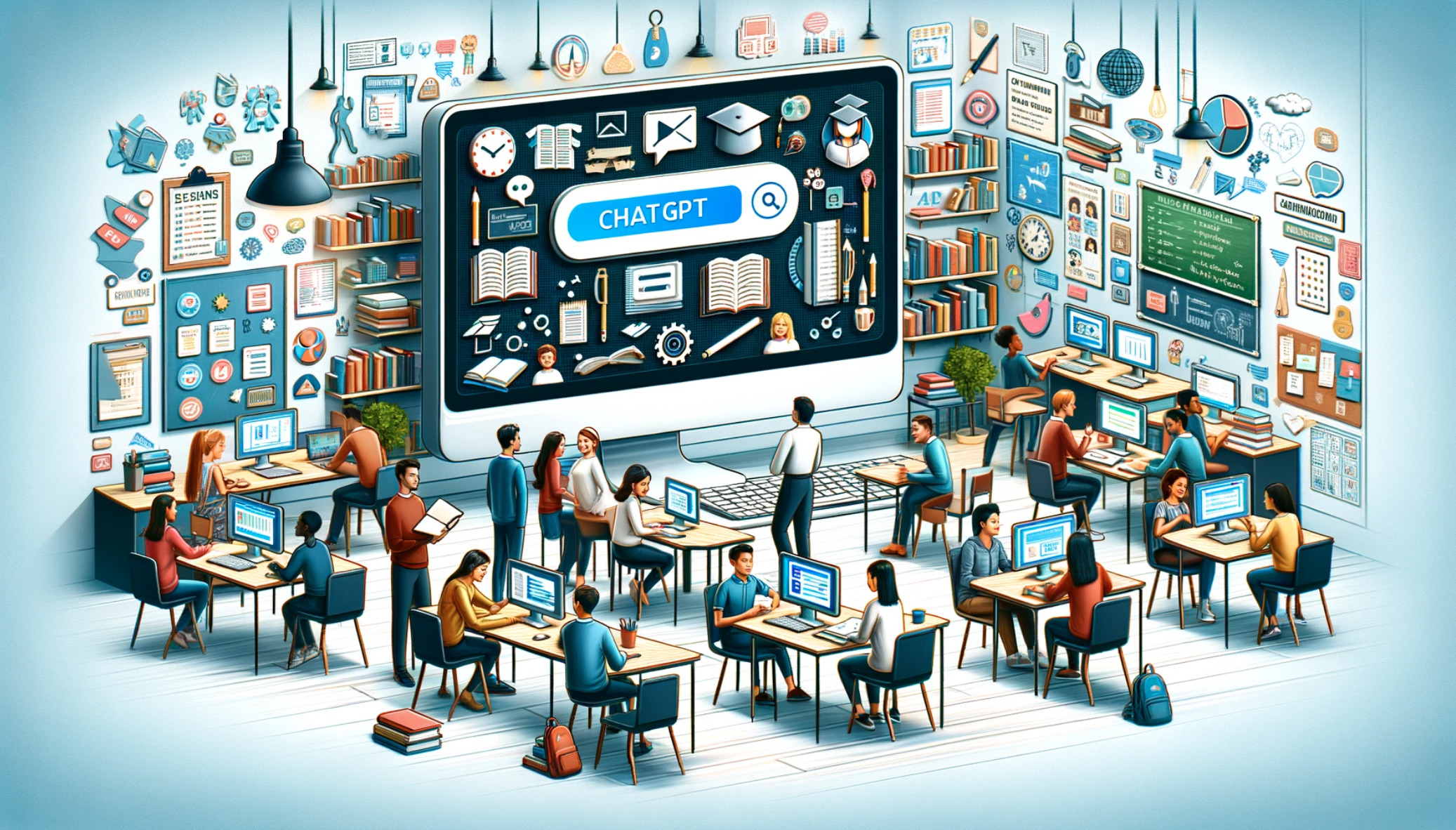
The integration of artificial intelligence and natural language processing technologies is revolutionizing the way educators create and deliver instructional content.
One of the AI-powered tools that has gained significant traction in the field of education is ChatGPT. This innovative technology can be a game-changer when it comes to creating engaging lesson plans and study guides that cater to the diverse learning needs of students.
In this comprehensive guide, we’ll explore how ChatGPT can be leveraged effectively in education to create high-quality lesson plans and study guides that foster student success.
Understanding ChatGPT
Before we dive into the specifics of using ChatGPT for educational purposes, let’s take a moment to understand what ChatGPT is and how it works.
ChatGPT is a language model developed by OpenAI. It’s powered by a variant of the GPT-3 architecture, a state-of-the-art deep learning model that excels in natural language understanding and generation.
ChatGPT is designed to generate human-like text responses to user input, making it an excellent tool for conversational applications and content generation.
In the context of education, ChatGPT can be used to help educators in any number of ways, such as creating lesson plans, generating study guides, answering student queries, and providing instant feedback on assignments.
The Importance of Effective Lesson Plans and Study Guides
Before delving into how ChatGPT can enhance the creation of lesson plans and study guides, let’s emphasize the importance of these educational tools.
Lesson Plans
Lesson plans serve as roadmaps for educators, guiding them through the teaching process. They outline the objectives, content, activities, and assessments for a specific lesson or unit. Well-structured lesson plans are crucial for:
- Clarity: Providing a clear and organized structure for both teachers and students.
- Alignment: Ensuring that instructional goals are aligned with curriculum standards.
- Engagement: Incorporating activities and strategies that actively engage students in the learning process.
- Assessment: Facilitating the evaluation of student learning and progress.
Study Guides
Study guides are essential resources for students, aiding them in their self-directed learning journey. A well-crafted study guide can:
- Focus Learning: Help students identify key concepts and topics to concentrate on.
- Organize Information: Present information in a structured and digestible format.
- Facilitate Review: Assist in reviewing and revisiting material for exams and assessments.
- Boost Confidence: Enhance students’ confidence in their ability to succeed academically.
Now that we’ve established the significance of lesson plans and study guides in the educational process, let’s explore how ChatGPT can be used to create them effectively.
Leveraging ChatGPT for Lesson Plans
Creating comprehensive and engaging lesson plans can be a time-consuming task for educators. ChatGPT can streamline this process and provide valuable insights and suggestions. Here’s how to harness the power of ChatGPT when crafting lesson plans:
1. Define Clear Learning Objectives
Begin by defining the specific learning objectives you want to achieve in your lesson. These objectives should be SMART (Specific, Measurable, Achievable, Relevant, and Time-bound). Use ChatGPT to help you articulate these objectives clearly and concisely. You can ask it to provide examples or rephrase your objectives for greater clarity.
2. Generate Content Ideas
ChatGPT can be a valuable resource for brainstorming content ideas. Describe the topic or subject you’re teaching, and ask ChatGPT to generate ideas for activities, discussions, or multimedia resources that can be incorporated into your lesson. It can give you a fresh perspective and suggest innovative approaches to teaching.
3. Organize the Lesson Structure
With ChatGPT’s assistance, you can structure your lesson plan effectively. Ask it to help you outline the sequence of activities, allocate time for each segment, and ensure a logical flow of content.
ChatGPT can also give you guidance on how to transition between different parts of the lesson smoothly.
4. Tailor Activities to Student Needs
Adapting lesson activities to suit the needs of diverse learners is a crucial aspect of lesson planning. ChatGPT can help you generate variations of activities that cater to different learning styles and abilities. For example, you can ask it to suggest modifications for kinesthetic learners or strategies to accommodate students with varying levels of prior knowledge.
5. Assessments and Evaluation
ChatGPT can assist in designing effective assessments and evaluation methods. Describe the desired learning outcomes and ask ChatGPT to propose assessment formats, questions, or rubrics that align with those outcomes. It can also help you create answer keys and grading criteria.
6. Incorporate Technology
Incorporating technology into lessons is increasingly important in today’s digital age. ChatGPT can provide insights into how to integrate educational technology tools, such as online simulations, interactive quizzes, or virtual labs, to enhance the learning experience.
7. Engage with Multimodal Content
To cater to diverse learning styles and preferences, consider incorporating multimedia elements into your lessons. ChatGPT can suggest relevant images, videos, or interactive resources that complement your content and engage students on multiple levels.
8. Foster Inclusivity
Ensure that your lesson plans are inclusive and accessible to all students. ChatGPT can help you identify potential accessibility barriers and suggest strategies to make your lessons more inclusive, such as providing alternative formats for content or accommodating students with disabilities.
9. Review and Refine
After creating your initial lesson plan draft with ChatGPT’s assistance, take the time to review and refine it. Make sure it aligns with your educational goals, the needs of your students, and any specific curriculum standards.
Crafting Effective Study Guides with ChatGPT
Study guides are valuable tools that aid students in independent learning and exam preparation. ChatGPT can play a significant role in generating study guides that are comprehensive and student-friendly. Here’s how to utilize ChatGPT for this purpose:
1. Identify Key Concepts and Topics
ChatGPT can help you identify the core concepts and topics that students need to focus on when studying. Describe the subject or course, and ask ChatGPT to provide a list of essential topics or concepts. This forms the foundation of your study guide.
2. Summarize Content
For each topic or concept, ask ChatGPT to provide concise summaries or explanations. These summaries should be easily digestible and provide students with a clear understanding of the subject matter.
You can also request the generation of brief examples or illustrations to enhance comprehension.
3. Create Visual Aids
Visual aids, such as diagrams, charts, and graphs, can greatly enhance the effectiveness of study guides. Use ChatGPT to suggest visual representations for complex concepts.
Describe the information you want to visualize, and ChatGPT can offer ideas for creating impactful visuals.
4. Provide Practice Questions
Include practice questions or problems in your study guide to help students reinforce their understanding and prepare for assessments. ChatGPT can assist in generating a variety of practice questions, complete with answers and explanations.
5. Offer Study Tips and Strategies
Students often benefit from study tips and strategies that improve their learning process. ChatGPT can provide advice on effective study techniques, time management, and test-taking strategies that students can use while working through the study guide.
6. Organize and Structure
Organize the study guide logically, following a sequence that mirrors the course content. ChatGPT can assist in arranging topics in a coherent order and providing suggestions on how to group related information.
7. Customize for Different Learning Styles
Consider the diverse learning styles of your students and customize the study guide accordingly. ChatGPT can provide recommendations for adapting the guide to cater to visual, auditory, or kinesthetic learners.
8. Review and Edit
After generating the study guide with ChatGPT’s help, thoroughly review and edit it. Ensure that it is clear, concise, and free from errors.
You can also add any specific instructions or additional resources that may be relevant to your students.
Best Practices and Considerations
While ChatGPT is a powerful tool for enhancing lesson plans and study guides, it’s important to keep some best practices and considerations in mind:
1. Verify Information
Always verify the accuracy of the information generated by ChatGPT, especially when creating study materials for academic subjects. Cross-reference information with reliable sources to ensure correctness.
2. Personalize Content
While ChatGPT can provide valuable suggestions, remember to personalize your lesson plans and study guides to meet the unique needs and preferences of your students.
3. Encourage Critical Thinking
Incorporate opportunities for critical thinking and problem-solving in your lesson plans. ChatGPT can assist in designing thought-provoking questions and activities that promote higher-order thinking skills.
4. Foster Collaboration
Consider using ChatGPT as a collaborative tool with fellow educators. Brainstorming and sharing ideas can lead to even more innovative lesson plans and study guides.
5. Privacy and Ethical Considerations
Be mindful of privacy and ethical considerations when using AI-powered tools like ChatGPT. Ensure that any data or student information is handled securely and in compliance with relevant regulations.
Conclusion
ChatGPT is a powerful ally for educators looking to create effective lesson plans and study guides that enhance the learning experience for students. By leveraging the capabilities of ChatGPT, educators can streamline the planning process, access valuable insights, and provide tailored resources that cater to the diverse needs of their students.
However, it’s essential to use ChatGPT responsibly and in conjunction with your expertise as an educator.
With the right approach, ChatGPT can be a valuable tool in the modern classroom, contributing to better learning outcomes and student success.





